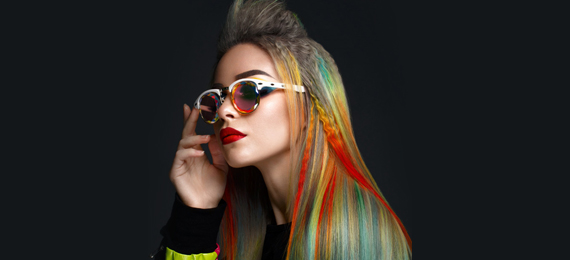Table Of Content

That includes using brushes and combs, applying the dye directly to the scalp, and using a hair net or cloth to wrap the hair. Aureole was initially sold to hairdressers in 1909, and it quickly gained popularity thanks to its effectiveness and relative safety.
Hair Dye History Timeline
In Italy, women began using a mixture of alum, sulphur, and quicklime to bleach their hair, often exposing it to the sun for hours to achieve a golden blonde hue. It’s the ratio of two types of melanin—eumelanin and pheomelanin—that determines your natural hair color. And it’s the size and shape that the melanin molecules form when they cluster in the hair shaft that give the unique tones within a hair color. For example, blondes and brunettes have about the same ratio of eumelanin molecules to pheomelanin molecules, but blondes have fewer molecules overall.

Color Mastery
Follow us @eSalon on Instagram and Facebook for more hair color inspo and exciting facts. With public opinion shifting, celebrities began to cash in on hair color’s success. Starlets Heather Locklear and Cybil Shepard were some of the first Hollywood stars to jump on the hair dye endorsement bandwagon during this decade, but they would not be the last. It wasn’t until Queen Elizabeth I took her reign in 1558 that red hair became an in-demand hair color. Her choice to embrace this rare hair color made it fashionable and sought after by the most prestigious members of the monarchy.
Greeks and Romans Used Plant Extracts for Hair Color
This democratisation of hair colour led to an increase in experimentation and creativity, with people embracing a wide range of hues and styles. Today, the hair dye industry is huge and dyeing your hair at home has become a common process – whether it’s to cover grey, change up your style, or restore your hair back to its original colour. Globally, hair-care products are the largest portion of the beauty industry and secure nearly a quarter of industry revenue.
Split Hair Two Tone Dye - #SplitHair - Refinery29
Split Hair Two Tone Dye - #SplitHair.
Posted: Wed, 13 May 2015 07:00:00 GMT [source]
Synthetic dyes
Hair color became commonplace by the late 1960s, with women experimenting with different shades of red. Henna was used to color gray hair and was an integral part of their beauty and grooming rituals. But this quick answer merely scratches the surface – to fully appreciate hair dye’s colorful history, the details await. Not only is eSalon hair color custom crafted for you and made from scratch, but our ammonia-free formulas are gentle on your strands which can help prevent damage.
Closely related to headgear, hairdressing has been an important part of the dress of both men and women since antiquity and, like the dress, serves a number of functions. The very first hair dryers were vacuum cleaners adapted for drying hair. Thermo hair curlers were invented by African American inventor Solomon Harper in 1930. The pressing/curling iron was patented by Theora Stephens on October 21, 1980. Early permanent wave machines used electricity and various liquids to perm hair and were difficult to use. In 1924, the first celebrity hairstylist, The hair of Mr. Antoine’s dog was colored blue.
Purple
The Victorian period was a time of immense transformation in many facets of life, including the realm of hair color. During this era, there was a remarkable shift in the history of hair coloring as women sought to make their locks more fashionable and attractive. Starting with natural dyes and ultimately progressing to chemical dyes, this article will analyze how hair color evolved throughout the Victorian era. The advent of chemical dyes represented a major switch in the history of hair coloring during the Victorian era. Women now had access to a broad selection of colors that could be easily kept up with minimal effort.
This made it possible for women to attain lighter shades of blonde or even red that had been inconceivable with natural dyes alone. Women would concoct dyes from natural ingredients such as henna and indigo, or mix them together to create various shades of browns, reds, and blacks. These concoctions were applied directly to the hair or mixed with water and brushed on.
For example, in medieval Europe, blonde hair was highly admired, and many women sought to achieve the look through various dyeing methods. However, as we move into the Renaissance, hair dye experimentation takes on new forms and reaches new heights. As we move into the Middle Ages, we find that hair dye continued to evolve, incorporating more advanced techniques and ingredients. In Europe, women often used herbal concoctions and vegetable extracts to achieve various shades of blonde and red. The use of alum, sulphur, and honey was common to create lighter hair colours, while henna and madder root were used to achieve darker shades.
This led to the emergence of various hair color trends, with different shades becoming fashionable at different times. A walkthrough of a museum exhibit on Ancient Egypt will highlight many of the amazing technological advances from thousands of years ago, but hair color might not make the cut. It’s true—ancient Egyptians were some of the first known people to use hair dye, applying henna to cover gray hair. Natural hair color was also used years later in Ancient Greece and Rome, where people pulled different plant extracts to modify the color of their hair.
Someone with dark hair wishing to achieve two or three shades lighter may need a higher developer whereas someone with lighter hair wishing to achieve darker hair will not need one as high. Timing may vary with permanent hair coloring but is typically 30 minutes or 45 minutes for those wishing to achieve maximum color change. However, modern hair colorants and dyes weren’t invented until much later.

No comments:
Post a Comment